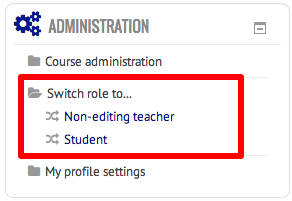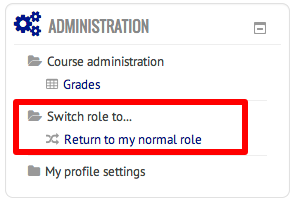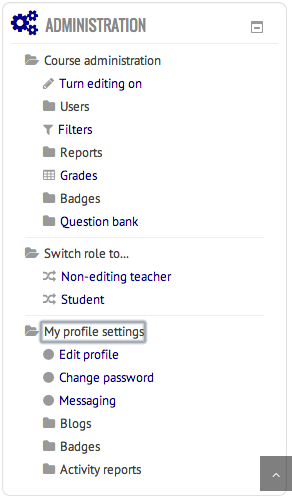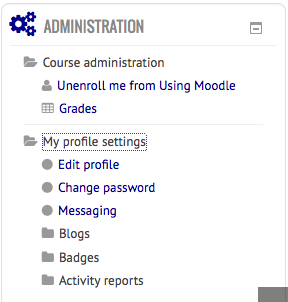Course Roles
| இணையம்: | Dr. Indira Koneru |
| பாடங்கள்: | Using Moodle copy 1 |
| Book: | Course Roles |
| Printed by: | Guest user |
| Date: | வெள்ளி, 19 டிசம்பர் 2025, 1:18 PM |
விளக்கம்
This provides information about course roles.
1. Roles
Just as in a classroom in a school, there are several roles available within Moodle. Here is an overview of the roles:As a teacher, the roles that you will be concerned about include the following:

1.1. Site Administrator
Site administrators have permissions to do anything. This role will be assigned only to a few individuals.
1.2. Manager Role
This is a role that is assigned at the management level.
The default Manager role enables users assigned the role to access courses and modify them, as well as perform certain administrative level tasks related to courses, users, grade settings, etc.
Unlike the administrator role, the Manager role is a 'real role', whose capabilities you can edit, but is similar to Administrator (but much safer to use) due to its broad default powers. As a normal role, like Course Creator or Teacher, while the Manager role has almost very many capabilities by default, you can edit that role if you choose.
(The way permission checks work in the Moodle code is that there is a function called has_capability. For admins, has_capability will always return true, no matter how the roles are set up. Thus there is no way to edit what permissions an Administrator has.)
Adopting a best-practice based on the Principle of Least Privilege suggests that Admins should normally use a Manager role, and not use an Administrator account, similar to the way you are recommended not to log into Linux as root.
The Manager role therefore allows a site Administrator to give very powerful roles to others who are assigned a Manager role, but without having to give them a full Administrator role.
1.3. Course Creator
This is also a top level role.
A user assigned the role of course creator can (as the name suggests!) create a course. If the setting "Creators' role in new courses" is left as default (teacher), then the course creator is enrolled as a teacher in the course they have just created and can then edit the course settings and enrol other users.
A course creator can also view hidden courses.
The role of course creator could typically be assigned to a master teacher, department head or program coordinator.
Creating a course
The "Add a new course" button can be found at the bottom of the page listing all courses.
When a course creator creates a course, they are automatically enrolled in the course as a teacher, or whatever role is set in Administration > Site administration > Users > Permissions > User policies.
Note (1): If a user is assigned the role of course creator in the course category context, the "Add a new course" button only appears when the course category contains at least one course.
Note (2): Course creators are not automatically assigned the role of teacher in a course they have not created, even if it is in a category where they have course creator rights.
Deleting a course
There is no user interface for course creators to delete courses they have created, however they can do so by editing the URL of the course from http://yourmoodlesite.net/course/view.php?id=N to http://yourmoodlesite.net/course/delete.php?id=N (replacing 'view' with 'delete').
Role assignment
A user may be assigned the role of course creator as a system role (in Administration > Site administration > Users > Permissions > Assign system roles) or in the course category context.
Role permissions
If you require a course creator to have additional permissions, it is recommended that the Manager role is used, rather than changing the course creator role permissions. Otherwise, allowing additional capabilities for the course creator role may result in course creators having access to courses which they have not created.
The role of course creator is ONLY intended for enabling users to create courses; it is not intended for enabling users to edit existing courses!
1.4. Feasibility Teacher
The Feasibility Teacher role is exactly what it says. It is designed to give "teacher powers" to that particular course.
Feasibility Teacher
Feasibility Teacher is the role for all teachers presenting the courses from the ATEP project. The feasibility teacher has limited powers. Feasibility teachers can control when activities are available for students. That is, feasibility teachers can show/hide information for students as needed. Feasibility teachers can also grade students and provide feedback.
Feasibility teachers can only teach in the courses they have been enrolled in.
Feasibility Teacher abilities:
- can show/hide material for students
- can grade
- Will be the teacher in the classroom
- Provides additional "real world" support
As the Feasibility teacher in the course, it may be useful to "see what the students see". This is possible by switching your role. Once you are signed into your course, you will see a "Switch role to.." link in the Administration block. Click that to reveal your options. (You may need to scroll down to see the Administration block).

As a Feasibility teacher, you will have two options: Non-editing teacher or Student. Clicking on the Student link will change your view so that what is presented is what a student would see. This can be very useful. Once you have clicked to view as another role, the menu option will change in the Administration block to "Return to my normal role".

Click the "Return to my normal role" link to restore your powers as a Feasibility teacher.
1.5. Non-Editing Teacher
Non-editing teacher
The non-editing teacher role can be very useful. Non-editing teachers are able to view and grade student assignments but can't make changes to the content of the course. This can be extremely useful for co-taught classes. The co-teacher can then help with grading but can't alter or delete any resources.
Non-editing teacher abilities:
- can see all of the same resources as a teacher
- Can grade students
Non-editing Teacher limitations:
- can not make changes to the material within a course
- Can not show/hide items from students
1.6. Student
Student Role
The student role is pretty straight forward. This is the role for students.
Students can participate in a course, complete assignments, view resources and see their own grades. They can't see the gradebook for the entire class.
Teachers can control what and when students see resources.
Students are limited in their choices and what they see. For example, a feasibility teacher will have many more options in the Administration block than a student.
Feasibility teacher Administration block:

Student Administration block

Notice that the Student is limited to two options in Course administration:
- Unenroll me from (the name of the course)
- Grades
The Feasibility teacher has many more options:
- Turn editing on
- Users
- Filters
- Reports
- Grades
- Badges
- Question bank
*Remember that teachers can switch to the Student role to "see what a student sees". (See the Feasibility teacher role for instructions on switching the view).
1.7. Guest
The Guest role allows a user to see the material in the site. However, a Guest can NOT take quizzes or complete assignments. The Guest role is being used in the ATEP site to provide access to those who would like to download and install the course in their own instance of Moodle.